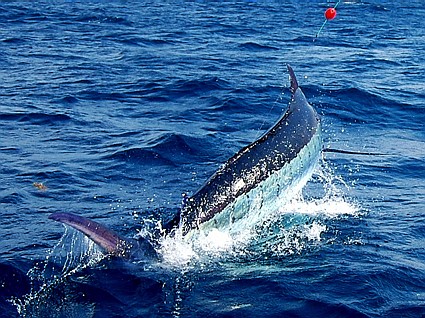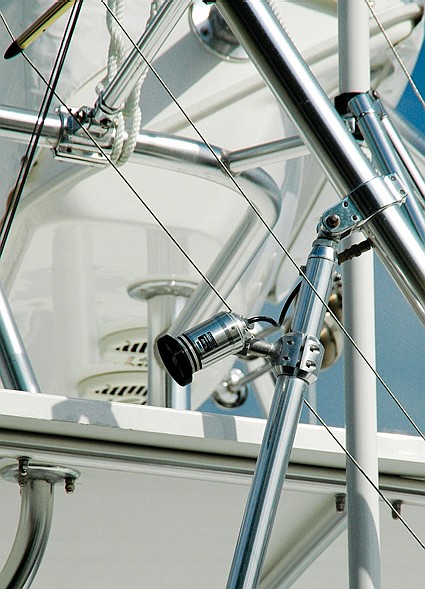January 29, 2012
By Jeff Weakley
Digital revolution brings true colors of marlin to the attention of anglers everywhere.
For decades, marlin tournaments thrived off the primal—if illusory—image of a man posing with his kill, in this case a huge, dead fish. At least, that's what dazzled the crowds. The angler, captain and crew knew the real excitement—the explosive strike, the long battle, the magnificent fish fighting in crystal blue water.
Today, tournaments have the technology to bring the action, instead of the fish, back to the dock.
Digital cameras, even video cams, are now standard equipment on boats fishing release billfish events. Scores are based on the identity of the species and the number released. Additional points are often awarded for successful placement of a tag.
Not surprisingly, these cameras have empowered legions of amateur photogs, and in turn ignited the daydreams of countless fellow anglers.
Take for example a series of incredible blue marlin pictures from the Miami Mayor's Cup Sailfish Tournament in late January.

Above, and two shots below, The crew of a Miami boat used a digital SLR to document Capt. Jimmy David's big blue marlin at the Mayor's cup. |
Amidst a flurry of bites off Fowey Light, Jimmy David, a professional captain, picked up a rod. A fish had eaten a live goggle-eye on the long kite line, and “I happened to be the one there,” David said. “My wife Debbie had just gotten her release, and we started chasing mine, assuming it was another sail. It wasn't until we got it to the boat that we could see what it was.”
Vessel owner Peter Hadrian, a resident of Palm Island, began clicking away on a Nikon D40. The skipper, Capt. Joe Turner, had recently purchased the camera for tournament season.
Typical of very large fish hooked on light tackle, the marlin showed little regard for an 8/0 circle hook and 5 pounds of drag. In fact, the fish neither ran far nor sounded.
Turner had the best view, piloting the boat from the tower.
“As it was coming up, we saw a tail, and the head—it looked like two fish,” Turner said. “Then it rose up and jumped, and we were like, ‘Holy %^#$!'”
The marlin stayed on the surface, no doubt a key reason for the successful release on 20-pound-test line and 60-pound-test leader—the equivalent of chasing giant tarpon with bluegill tackle. “The fish jumped like 25 times,” David said. “I later talked to my friend, Art Sapp, on Native Son, who said he could see it from a half-mile away. We were right next to Miss Britt, and they said it was amazing to see. The fish never really got much more than 50 feet out—and we got the release on it.”
“I've caught a half-dozen blue marlin, but none close to that,” David said, reflecting on 25 years of fishing off South Florida. “My brother, Freddie, had just gotten back from Panama, where he'd seen a lot of big fish—and he said this one was probably 500 pounds.”
“It was the biggest blue any of us have caught out there,” Turner said. “We'll probably never see one like that again.”
The somewhat bitter irony was, that particular tournament scores marlin and sailfish equally. Native Son went on to win the two-day event with 10 sails, but Hadrian's images captured the attention of South Florida anglers, who live and breathe sails, but dream of big blue marlin.
A quarter-ton blue could mean big money at a lot of Florida events, a hundred grand or more at the Panama City Bay Point Invitational, one of the region's biggest, most heavily publicized marlin tournaments. Even here, the fish would be documented and released with reverence. It's all part of a trend which began in the 1980s, when the public became aware of a precipitous decline in marlin numbers. Atlantic marlins have been protected from commercial sale in U.S. waters since 1988, but mortality remained terribly high through the late '90s, as the big fish perished after ingesting baits on multi-hook commercial swordfish and tuna longlines.
Today, commercial longlines are prohibited from fishing in certain waters, including the Florida Straits. High-seas bykill by foreign fleets remains a big problem. As for sportfishermen—a flyspeck threat by comparison—the U.S National Marine Fisheries Service (NMFS) has implemented a fleet-wide retention limit of no more than 250 blue and white marlin, combined, for the year. Billfish tournaments must register with the NMFS Highly Migratory Species Division; owners of private vessels must purchase annual HMS permits. Landings of marlin and certain other large fish must be reported immediately, by phone or via the Web.
But unless it's swordfish steaks you're after, there's not much reason to call NMFS.
Judging by the crowds at the JumboTron screen at the Bay Point Marina, video is the future of marlin tournaments, from both a conservation and crowd-pleasing standpoint, says director Scott Burt.
“We've always drawn huge crowds at the weigh-in,” Burt said of the invitational tournament, heading into its 25th year this summer. “For 20-odd years, people were used to seeing dead, bleeding, gray carcasses hanging up. The first year we ran video, I couldn't believe their reaction—they were stunned. They saw in living color how gorgeous the Gulf is, 60, 70 miles out...and they had no idea the boats chased fish. Their jaws dropped when they saw the transom underwater, the angler and mate just about killing themselves. And video of fish tail-walking? It blew them all away.”

Outrigger-mounted video cam on a Stuart ch
arterboat, above, can broadcast tournaments live, like the Panama city Bay Point, below. Footage earns hoots and possible cash prizes. |
Since that first showing, four years ago, Burt has stepped up to the 14- by 20-foot JumboTron.
There are still weigh-in divisions for tuna, dolphin and wahoo, but the big crowd-pleasers are the video clips from participating vessels.
It's a natural byproduct of the release format, Burt explained, wherein teams are required to film segments of the battle along with a “designator”—an item provided to the boats just before heading out, to verify that the action occurred during the Friday-Saturday tournament.
Blue marlin releases earn 600 points; whites and sailfish, 250. As “meat fish” are weighed in for each team, Friday or Saturday evening, video action is played for the crowd, and the anglers talk about their catches.
This year's 25th Bay Point Invitational will be July 9-13, and for the first time it's all-release on billfish. If that's not enough of a heart-warmer, there'll be the inaugural Al Hubbard Take a Kid Fishing Tournament on Friday, catering to at-risk youth. Hubbard, a longtime FS Field Editor, was Bay Point emcee for years. He passed away in 2004.
Outside the tournament arena, for Florida anglers who spend long hours on the blue water, a marlin is a matter of time and luck. Blues are top-tier predators, chasing dolphin and tuna schools in deep, warm water. Occasionally they venture in as shallow as 100 feet, within range of 20-foot vessels on about 50 percent of the Florida coast. Some Panhandle, Northeast Florida and Bahamas anglers specialize in trolling for blues using big lures or rigged dead baits. But untold numbers are hooked each year on simple ballyhoo/skirt rigs aimed at dolphin. White marlin, smaller and differentiated by rounded pectoral and dorsal fins, also make surprise appearances. Just days after releasing the big blue at the Mayor's Cup, Capt. Jimmy David had a white release on his L&H charterboat, and two other Miami boats caught whites, same day, same area. All three were hooked on typical sailfish rigs—live goggle-eyes under kites.
Having a camera on board to capture these memories is now seen as essential; having a kill gaff and meat hooks is not.
The revolutions in capturing marlin come at a perfect time. There seems to be a resurgence of the fishery in our waters, as judged by remarks by veteran observers and by an increasing frequency of sightings and releases by anglers.
Captain Rick Ryals of Jacksonville reports an upswing in recent years, with some Northeast Florida boats having 2-fish release days on marlin during the prime period of April through June. Ryals tracks the bite very closely, on the water and on the phone lines as FS Live Radio host. Average size blue is 150 to 180 pounds.
“The fish are there when the food's there,” he said. “When dolphin, bonito and wahoo are here, it's a great time to fish—but you'll have to ignore those fish, fishing deeper water, bigger baits.
“Blue water, warmer than 78 degrees, generally deeper than 300 feet, with flyingfish in the area—that's where you'll want to concentrate. Most of our fishing is lure fishing, as there's a lot of hunting between bites. Natural bait speeds, you're covering 7 or 8 miles in an hour; with lures, you'll cover 14.”
On the other side of the state, Capt. Buck Hall, FS Panhandle Field Editor, mentioned a similar uptick in catches. For crews in the northern Gulf of Mexico, the approach is more structure-oriented than it is on the Atlantic coast. Starting around 30 miles off Pensacola is a series of dropoffs associated with the so-called “Nipple”—an anatomically eponymous feature apparent on deepwater charts.
“Right around 250 feet, you can start fishing,” Hall says. “If you see bait—hardtails, mackerel, anything—slow down.” Vessels with greater range—such as the 65-footer Hall commonly fishes aboard—may set autopilots for petroleum and natural gas drilling rigs starting at 70 miles. “There's bait at the rigs year-round; we'll fish a lot of rigged Spanish mackerel, or live bait with big baits—even a 15-pound dolphin, because that's what a 600- or 700-pound marlin eats.”
Given the great distances and fuel costs associated with these quests, both Ryals and Hall give a nod to satellite-based ocean forecasting services, such as Roff's, Hilton's and others.
Whether captured by design or simple luck, marlin release images receive universal acclaim. Recently, in the Southeast section of the online Florida Sportsman Forum (www.floridasportsman.com), “ChinchBug” posted shots of a big blue caught off Jupiter. He misspelled marlin (“mrarline”) and confessed, “I don't fish for these guys...what do you think it weighed?”
Scrolling down the screen, one can't help but get chills: brilliant blue water, a bent rod, angler smiling, a purple fish with electric blue stripes. Several Forum members guessed in the 300s.
If you have the resources, getting footage like this doesn't even have to tie up a crewmate.
Vessel-mount, automated video cameras have come down in price a lot in the last few years. Antonio Seicentos, owner and president of Pro Audio & Video Systems Corp. in Miami, said the market's now booming for High Definition video. “We sell several models in the $2,000 to $5,000 range. Used to be I'd say, ‘People will never buy Christmas presents in our place, because back then the average price was $15,000 to $25,000.' Now they're buying Christmas presents!

Clearly, a marlin doesnt have to die to get the blood flowing. Bay Point victory, 2007. |
“Today people are able to make really good video, really inexpensively,” he explained. “Lots of cams are totally automated—they can be installed on outriggers or T-tops—and the video you'll get is good quality. All you need is a remote device to turn the camera on when the rod goes off.”
Seicentos knows all about the benefits of onboard video, from both a tournament and enjoyment perspective. A longtime Miami fisherman, he's been pursuing big marlin off El Salvador going on 11 years.
Saltwater exposure is obviously a concern. A typical HD cam used regularly on the boat will see about 20 percent of its usual life expectancy, Seicentos said. Builder Latham Cams (www.lathamcams.com) offers miniature cameras in waterproof housings, with brackets for mounting just about anywhere, plus underwater cameras which can be submerged on a small pole. Through dealers such as Pro Audi & Video, Latham sells camera sets complete with monitors and hardware.
Indeed, if Saturday-morning cable TV is any indication, a well-equipped marlin fisher
man can make himself not only a richer, more famous man, but a television star to boot!
FS

